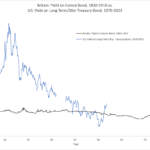January 22, 2024
Dedollarization is not just geopolitics, economic fundamentals matter
Over the past decade, many countries—primarily emerging markets—have endeavored to reduce their reliance on the US dollar in global payment transactions. Some of the push for dedollarization is in reaction to the perceived overreach of US financial power—particularly following Russia’s invasion of Ukraine and the G7’s sanctions response. However, that is only part of the story.
Private firms around the world are the ultimate decision makers regarding the international use of the dollar and they respond to the incentives facing them, namely access to and costs of dollar financing. And, for the first time in nearly 20 years, it is substantially cheaper to conduct short-term borrowing in renminbi (RMB) rather than dollars. In other words, a portion of the dedollarization trend is driven not only by geopolitics but also by interest rate differentials.
Fluctuations in the dollar’s global dominance is not a recent phenomenon. As a reserve asset, for example, the dollar composed nearly 80% of global reserves in 1970. By 1980, that number fell below 58 percent. It then plummeted to 47 percent in 1990. The dollar recovered to around 71 percent of global reserves in 1999, though it has since declined gradually to 59 percent in 2020—not in favor of any replacing currency, but a number of smaller currencies including the RMB. Current trends in dedollarization in global payment must be seen with this historic context. While this is an important trend for policy makers to watch, given its underlying drivers, they should be careful not to attribute all the motivation to geopolitical tension, possibly leading to wrong policy conclusions.
The dedollarization story so far
The reluctance to use the dollar has not been driven by the rise of a competing currency such as the RMB, but more importantly by the growing trend of using local currencies in bilateral cross-border payments. However, because of China’s large footprint in international trade and investment, the RMB’s usage in international transactions has captured increasing attention as the primary challenger to the dollar, following a rapidly growing number of bilateral cross-border payment arrangements.
Analysts, including our Dollar Dominance Monitor, have pointed to a range of signs indicating a growing risk to the dollar. Last year, global payments settlements using RMB nearly doubled, albeit from a low base of 1.91 percent at the start of 2023 to 4.61 percent in November 2023. The SWIFT data may underestimate the RMB’s true international usage because it may fail to reflect uses of RMB in bilateral cross-border payments facilitated by central banks’ currency swap arrangements. On the other hand, about 80 percent of the use of RMB outside of China takes place in Hong Kong—without Hong Kong, the international use of the RMB remains quite small. More importantly for China, about half of its bilateral cross-border trade and investment transactions are now settled in RMB, reducing its vulnerability to US financial sanctions.
Some of this shift is in response to G7 sanctions imposed following Russia’s illegal invasion of Ukraine in early 2022. Those measures reanimated concerns across global capitals around the risks of overreliance on Western financial infrastructure and the US dollar and generated urgent demand for alternatives to the US-led financial system. But this is not the only explanation and too much focus on it can lead analysts to overestimate the costs of those sanctions. In fact, the dollar was also facing macroeconomic headwinds and its use in cross-border payments likely would have declined to some extent even without the Russia sanctions.
Macroeconomic headwinds for the dollar
Countries at risk of sanctions, like China and Russia, are the largest individual contributors to dedollarization but they are not alone. As Bloomberg’s Gerard DiPippo points out, Russia-China trade accounts for only 27 percent of the increase in trade settlement in RMB. The remaining 70 percent is likely RMB-denominated trade with Beijing’s neighbors primarily in Asia, but also abroad such as Argentina, Brazil, and the Gulf countries. Without the imminent threat of US sanctions on Beijing, this shift to RMB trade is likely motivated more by lending costs and availability.
It’s important to understand the integral role trade finance plays in facilitating global commerce. Payments are not made instantaneously; there is a gap from the time firms receive payments for the goods they ship and when they need to pay suppliers for those same goods. Firms often turn to banks to provide loans to help bridge the gaps. Because of this, firms seeking to minimize financing costs pay close attention to the relative cost of capital and available dollar liquidity. Rate hikes by the US Federal Reserve (Fed), which coincidentally began to take full effect in the months after Russia’s invasion of Ukraine, have caused borrowing in dollars to become more expensive and scarcer, encouraging emerging market firms to seek dollar alternatives—namely the RMB.
Relative costs of capital
For the first time in nearly 20 years it is substantially cheaper to conduct short-term borrowing in RMB rather than dollars. Borrowing costs, as measured by the proxy of a one-year government bill, imply short-term borrowing in RMB is around two percentage points cheaper than analogous borrowing in dollars. This is pushing firms, particularly those engaging with Chinese individuals and firms on either end of the transaction, towards RMB-denominated debt for trade financing to take advantage of efficiency gains.
This surge in dollar borrowing costs reflects the US Federal Reserve’s rapid rate hike campaign to rein in US inflation, which had hit 8.5 percent. China has not experienced the same sort of surging inflation, so was able to leave its short-term rates largely constant. Notably, this flip in relative financing costs happened in close proximity to Russia’s invasion of Ukraine. This may have caused some commentators to solely attribute firms shifting their trade finance arrangements from dollars to RMB to the overuse of US sanctions.
Dollar liquidity squeezes
A second, related, macrotrend disincentivizing dollar use in international trade is the appreciation of the dollar and its impact on dollar liquidity in emerging markets. In early 2022 the value of a dollar against a basket of global currencies jumped 19.8 percent from right before the start of the invasion to its peak in October 2022. While its value has dropped in the year since, the dollar’s value still remains elevated by around 10 percent compared to its pre-invasion average. This was also caused by Fed rate hikes; higher rates increased the value of dollar-denominated assets, which created strong incentives for global investors to buy dollars to buy those assets. The war amplified this. Investors also increased their dollar holdings as they view the dollar as a “safe haven asset” and expect the currency to retain, or even gain value during periods of global instability and economic downturn.
An appreciating dollar severely restricts dollar funding availability, particularly for emerging market firms who are more reliant on dollar-denominated credit. This is because a stronger dollar comes with incentives for lenders with large dollar liabilities to curb their willingness to provide new short-term dollar loans (such as the borrowing required for firms seeking to finance trade) and raise the rates they are willing to lend at—further amplifying the relative cost of capital effects discussed earlier.
The Bank for International Settlements (BIS) finds that after the dollar appreciates, “banks with high reliance on dollar short-term funding reduce supply of credit more to the same Firm relative to banks with low short term dollar funding exposures.” The BIS continues, pointing out, “firms that borrowed from short-term dollar-funded banks will suffer a greater decline in credit following dollar strengthening.”
Without abundant dollar financing alternatives, such as during the 2008 financial crisis, the impact of this would have subdued global trade. However, following concerted efforts by Beijing to promote RMB-denominated lending, firms seeking short-term finance can now turn to RMB lenders or RMB-denominated debt markets. Indeed, in the past year overseas units of Chinese firms, as well as Western companies like BMW and Crédit Agricole, have raised a record 125.5 billion RMB ($17.33 billion) selling RMB-denominated bonds during the January-October 2023, a 61 percent increase from the same period last year.
As rising dollar borrowing costs and decreasing dollar liquidity push firms to adopt the RMB for their trade financing needs, they are also more willing to engage with the alternative global financing infrastructure China is developing. In 2015, Beijing launched the Cross-Border Interbank Payment System (CIPS) to connect and control its own plumbing in the global financial system. The intention was to construct a new financial architecture to clear and settle transactions in RMB and facilitate the use of the currency in international business. Since 2015 CIPs has rapidly grown, settling just over 480B RMB ($75 billion) in Q4 2015 to 33.4T RMB ($4.6 trillion) in Q3 2023. While CIPS’ utilization growth has been largely steady since its inception, it does seem to experience substantial spikes following contractions in dollar lending availability. And though geopolitical trends may be integral in informing the strategic thinking around firms’ actions, outside of firms engaging with Russia, availability of liquid debt and efficient markets are a more likely proximate explanation for recent trends among emerging-market dedollarization.
Importantly, geopolitics and macroeconomic trends can work together to support dedollarization efforts. One example is China’s push to denominate more of its Belt and Road Initiative (BRI) lending in RMB. Since its inception in 2013, China has hoped to use the BRI as a tool to promote the international use of its currency. In its first five years Beijing had mixed success at best, with the majority of BRI debt denominated in dollars. This can be explained in part by discrepancies in borrowing costs over the same period. Similar to the large difference in short term lending which provided a cost advantage to US denominated debt throughout most of the 2010s, longer term borrowing was also skewed in the dollar’s favor. A $5 billion loan Beijing offered to Indonesia in 2017 demonstrates this. The loan is split between RMB and dollars with 60 percent denominated in US dollars, carrying a 2 percent interest rate, and 40 percent in RMB, carrying a 3.4 percent rate.
However, as rates converged in 2018 and onward, China had more success encouraging RMB-denominated debt. By 2020 loans in the Chinese currency overtook dollar denominated debt. While a convergence in interest is not the sole explanation for Beijing’s success, it’s undoubtedly easier to encourage countries to adopt debt in RMB if they cannot point to high opportunity costs by not borrowing in dollars.
The future of dedollorization
There are important structural limitations to the international use of the RMB. Prime among them is that the RMB is not freely convertible. Foreign firms that hold RMB or RMB-denominated assets are operating under the direct oversight of the Chinese government, whose interests may not always align with their own. This will give pause, particularly to firms based in advanced economies. China’s legal system also gives firms pause. As Chinese President Xi Jinping has centralized authority, the Chinese system has become increasingly opaque and volatile, offering little protection or recourse for firms who are harmed by central government actions. Finally, China’s financial markets remain less well developed and supervised than their Western counterparts. In particular, China’s bond markets are still far less developed and less liquid than US treasury markets. Though they have been valued at around $8 trillion in recent years, they pale in comparison to the US which is pushing $30 trillion.
Even so, in the coming year macroeconomic trends will likely continue to push emerging market firms towards RMB-denominated debt for trade financing in particular, amplifying the use of the RMB in international trade. While the Fed will likely begin to cut key rates later this year, decreasing the cost of US capital and borrowing, it’s unlikely Washington returns to the near-zero target rates that supercharged cost advantages for borrowing in dollars.
It will be key for policy makers to disaggregate these macro effects from the very real geopolitical backlash against sanctions and similar tools that are also pushing countries to explore dollar alternatives. Without understanding the relative importance of both trends, US and allied policy makers risk overestimating global sanctions backlash, possibly imperiling the G7 economic response to Russia’s illegal invasion of Ukraine.
Niels Graham is an associate director for the Atlantic Council GeoEconomics Center where he supports the center’s work on China’s economy and US economic policy.
Hung Tran is a nonresident senior fellow at the Atlantic Council’s GeoEconomics Center, a former executive managing director at the Institute of International Finance and former deputy director at the International Monetary Fund.

At the intersection of economics, finance, and foreign policy, the GeoEconomics Center is a translation hub with the goal of helping shape a better global economic future.
Further reading
Image: Hong Kong – January 27, 2023 : People at the RMB Exchange Shop in Causeway Bay, Hong Kong.




















